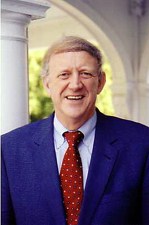Thomas Groome is chair of the Department of Religious Education and Pastoral Ministry as well as professor of theology and religious education at Boston College, where he has taught since 1976. Groome has written numerous books on religious education, including the now classic Christian Religious Education: Sharing Our Story and Vision (1980), which introduced his shared Christian praxis approach. His latest book is Will There Be Faith? A New Vision for Education and Growing Disciples (2011).
Book Basics
I read Groome’s Christian Religious Education while in seminary (the only text written by a Catholic included in my reading list for my basic course in religious education), and was intrigued to see how his perspective changed over the last thirty years. Both volumes provide theologically and pedagogically sound understandings of the enterprise known as religious education. Additionally, both offer import contributions to the conversation, especially with regard to the “how” one engages in the shared praxis. Note how the “how to” component shifts (and remains the same) between 1980 and 2011:
THEN
- First Movement: Naming Present Action
- Second Movement: The Participants’ Stories and Visions
- Third Movement: The Christian Story and Vision
- Fourth Movement: Dialectal Hermeneutic Between the Story and Participants’ Stories
- Fifth Movement: Dialectal Hermeneutic Between the Vision and Participants’ Visions
NOW
Focusing Act (FA): Engage people with a real life or faith theme.
- Life
- M1 (Movement 1): Have people respond to the theme as it pertains to their lives.
- M2: Encourage them to reflect critically on the theme in conversation together
- Faith
- M3: Share the Story and Vision of Christian faith in ways pertinent to the theme and meaningful for this group, context and occasion.
- Life
- M4: Encourage participants to appropriate and integrate Christian faith with life.
- M5: Invite people to make a decision – cognitive, affective, or behavioral in response to the whole process (p.299-300).
So What?
Christian religious education is changing for many reasons including, at the parish level, a different set of expectations and participation by a new generation of would-be disciples and their children. Groome’s approach delivers on its promise to be “contemporary, natural, holistic, and flexible” (p.5) without becoming faddish, simplistic, or rigid. It is born of a Catholic (Roman Catholic at times more than catholic) perspective, but applicable to a much wider audience.
- How has Christian religious education for children and youth changed in your congregation over the last 30 years? for adults?
- If your board/committee/leadership team responsible for Christian education and/or any staff members were asked to explain “how” they go about the overall task of religious education, how would they respond?
- Do you find Groome’s latest “how to” framework to be helpful for religious education in all contexts – including home, school and parish? Why or why not?
Thomas H. Groome. Will There Be Faith? A New Vision for Education and Growing Disciples (HarperOne, 2011). ISBN: 9780062037282.
